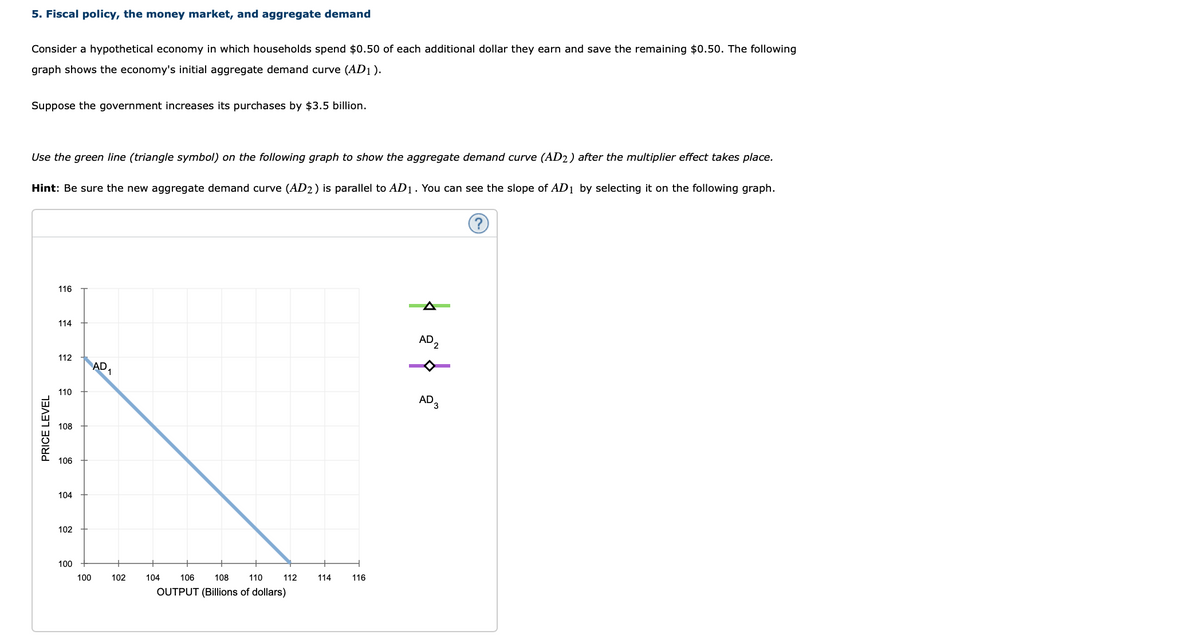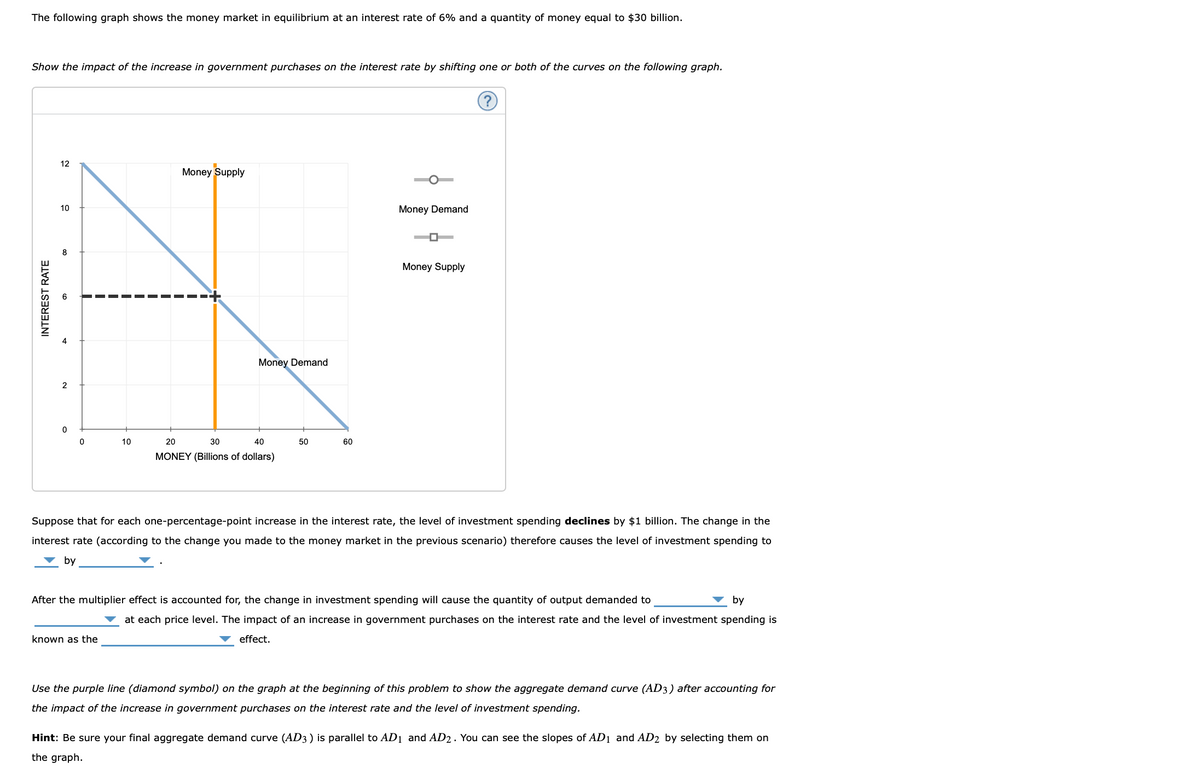Consider a hypothetical economy in which households spend $0.50 of each additional dollar they earn and save the remaining $0.50. The following graph shows the economy's initial aggregate demand curve (AD1). Suppose the government increases its purchases by $3.5 billion. Use the green line (triangle symbol) on the following graph to show the aggregate demand curve (AD2) after the multiplier effect takes place. Hint: Be sure the new aggregate demand curve (AD2) is parallel to AD1. You can see the slope of AD1 by selecting it on the following graph. 116 114 AD, 112 AD 110 AD, 108 106 104 102 100 100 102 104 106 108 110 112 114 116 OUTPUT (Billions of dollars) PRICE LEVEL కక్లి క్రి
Consider a hypothetical economy in which households spend $0.50 of each additional dollar they earn and save the remaining $0.50. The following graph shows the economy's initial aggregate demand curve (AD1). Suppose the government increases its purchases by $3.5 billion. Use the green line (triangle symbol) on the following graph to show the aggregate demand curve (AD2) after the multiplier effect takes place. Hint: Be sure the new aggregate demand curve (AD2) is parallel to AD1. You can see the slope of AD1 by selecting it on the following graph. 116 114 AD, 112 AD 110 AD, 108 106 104 102 100 100 102 104 106 108 110 112 114 116 OUTPUT (Billions of dollars) PRICE LEVEL కక్లి క్రి
Chapter22: Aggregate Demand And Aggregate Supply
Section: Chapter Questions
Problem 12P
Related questions
Question
What are the shifts of both of the graphs provided? (I need this questions to be answered ASAP!!!)
1st Blank options are fall or rise
2nd Blank options are $1 billion, $2 billion, $4 billion
3rd Blank options are increase or decrease
4th Blank options are $2 billion, $1.6 billion, $4 billion
5th Blank options are crowding out, liquidity preference, multiplier, and automatic stabilizer

Transcribed Image Text:5. Fiscal policy, the money market, and aggregate demand
Consider a hypothetical economy in which households spend $0.50 of each additional dollar they earn and save the remaining $0.50. The following
graph shows the economy's initial aggregate demand curve (AD1).
Suppose the government increases its purchases by $3.5 billion.
Use the green line (triangle symbol) on the following graph to show the aggregate demand curve (AD2) after the multiplier effect takes place.
Hint: Be sure the new aggregate demand curve (AD2) is parallel to AD1. You can see the slope of AD1 by selecting it on the following graph.
116
114
AD,
112
AD,
1
110
AD,
108
106
104
102
100
100
102
104
106
108
110
112
114
116
OUTPUT (Billions of dollars)
PRICE LEVEL

Transcribed Image Text:The following graph shows the money market in equilibrium at an interest rate of 6% and a quantity of money equal to $30 billion.
Show the impact of the increase in government purchases on the interest rate by shifting one or both of the curves on the following graph.
12
Money Supply
10
Money Demand
8
Money Supply
Money Demand
2
10
20
30
40
50
60
MONEY (Billions of dollars)
Suppose that for each one-percentage-point increase in the interest rate, the level of investment spending declines by $1 billion. The change in the
interest rate (according to the change you made to the money market in the previous scenario) therefore causes the level of investment spending to
by
After the multiplier effect is accounted for, the change in investment spending will cause the quantity of output demanded to
by
at each price level. The impact of an increase in government purchases on the interest rate and the level of investment spending is
known as the
effect.
Use the purple line (diamond symbol) on the graph at the beginning of this problem to show the aggregate demand curve (AD3) after accounting for
the impact of the increase in government purchases on the interest rate and the level of investment spending.
Hint: Be sure your final aggregate demand curve (AD3 ) is parallel to AD1 and AD2. You can see the slopes of AD1 and AD2 by selecting them on
the graph.
INTEREST RATE
st
Expert Solution
This question has been solved!
Explore an expertly crafted, step-by-step solution for a thorough understanding of key concepts.
This is a popular solution!
Trending now
This is a popular solution!
Step by step
Solved in 4 steps with 3 images

Knowledge Booster
Learn more about
Need a deep-dive on the concept behind this application? Look no further. Learn more about this topic, economics and related others by exploring similar questions and additional content below.Recommended textbooks for you

Exploring Economics
Economics
ISBN:
9781544336329
Author:
Robert L. Sexton
Publisher:
SAGE Publications, Inc



Exploring Economics
Economics
ISBN:
9781544336329
Author:
Robert L. Sexton
Publisher:
SAGE Publications, Inc




